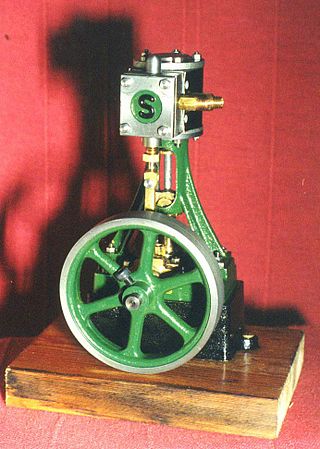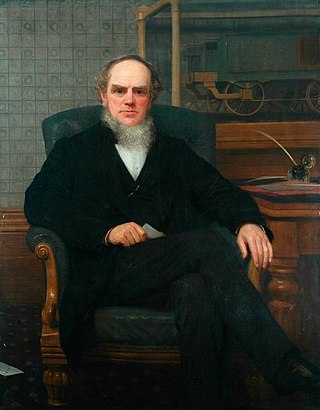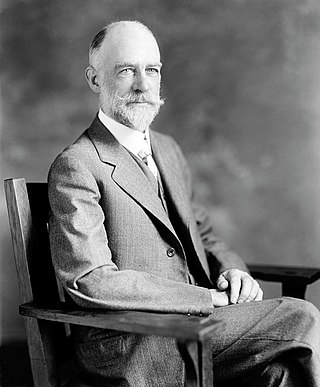Related Research Articles

James Watt was a Scottish inventor, mechanical engineer, and chemist who improved on Thomas Newcomen's 1712 Newcomen steam engine with his Watt steam engine in 1776, which was fundamental to the changes brought by the Industrial Revolution in both his native Great Britain and the rest of the world.

James Hall Nasmyth was a Scottish engineer, philosopher, artist and inventor famous for his development of the steam hammer. He was the co-founder of Nasmyth, Gaskell and Company manufacturers of machine tools. He retired at the age of 48, and moved to Penshurst, Kent where he developed his hobbies of astronomy and photography.

William John Macquorn Rankine was a Scottish mathematician and physicist. He was a founding contributor, with Rudolf Clausius and William Thomson, to the science of thermodynamics, particularly focusing on its First Law. He developed the Rankine scale, a Fahrenheit-based equivalent to the Celsius-based Kelvin scale of temperature.

Model engineering is the pursuit of constructing proportionally-scaled miniature working representations of full-sized machines. It is a branch of metalworking with a strong emphasis on artisanry, as opposed to mass production. While now mainly a hobby, in the past it also had commercial and industrial purpose. The term 'model engineering' was in use by 1888. In the United States, the term 'home shop machinist' is often used instead, although arguably the scope of this term is broader.

John Ramsbottom was an English mechanical engineer. Born in Todmorden, then on the county border of Yorkshire and Lancashire. He was the Chief Mechanical Engineer for the London and North Western Railway for 14 years. He created many inventions for railways but his main legacy is the split metal piston ring, virtually all reciprocating engines continue to use these today.
The Institution of Mechanical Engineers (IMechE) is an independent professional association and learned society headquartered in London, United Kingdom, that represents mechanical engineers and the engineering profession. With over 120,000 members in 140 countries, working across industries such as railways, automotive, aerospace, manufacturing, energy, biomedical and construction, the Institution is licensed by the Engineering Council to assess candidates for inclusion on its Register of Chartered Engineers, Incorporated Engineers and Engineering Technicians.

William Frederick Durand was a United States naval officer and pioneer mechanical engineer. He contributed significantly to the development of aircraft propellers. He was the first civilian chair of the National Advisory Committee for Aeronautics, the forerunner of NASA.

Robert Henry Thurston was an American engineer, and the first Professor of Mechanical Engineering at Stevens Institute of Technology.
Anthony George Maldon Michell FRS was an Australian mechanical engineer of the early 20th century.
Richard Leslie Hills MBE was an English historian and clergyman who wrote extensively on the history of technology, particularly steam power. He helped to found Manchester's Science & Industry Museum, where he was its first lecturer-in-charge.

Robert Napier was a Scottish marine engineer known for his contributions to Clyde shipbuilding.

William Cawthorne Unwin FRS was a British civil and mechanical engineer. He is noted for his extensive work on hydraulics and engines as well as his close association with William Fairbairn. He is one of only a few men who have served as president of both the Institution of Civil Engineers and the Institution of Mechanical Engineers. Unwin served as an engineering advisor to the government during the First World War and was the first recipient of the Kelvin Gold Medal awarded by the Institution of Civil Engineers.

The Institution of Engineers in Scotland (IES) is a multi-disciplinary professional body and learned society, founded in Scotland, for professional engineers in all disciplines and for those associated with or taking an interest in their work. Its main activities are an annual series of evening talks on engineering, open to all, and a range of school events aimed at encouraging young people to consider engineering careers. Between 1870 and 2020 the institution was known as the Institution of Engineers and Shipbuilders in Scotland (IESIS).
W. Alec Osborn, is a British mechanical engineer.

The Engineering Heritage Awards, formally known as the Engineering Heritage Hallmark Scheme, were established by the Institution of Mechanical Engineers (IMechE) in 1984 to identify and promote artefacts, locations, collections and landmarks of significant engineering importance.

Verena Winifred Holmes was an English mechanical engineer and multi-field inventor, the first woman member elected to the Institution of Mechanical Engineers (1924) and the Institution of Locomotive Engineers (1931), and was a strong supporter of women in engineering. She was one of the early members of the Women's Engineering Society, and its president in 1931. She was the first practising engineer to serve as president of the society.

The Internal Fire Museum of Power is a museum of internal combustion engines in West Wales. The museum's collection is mostly of larger stationary diesel engines, as used for generating sets and pumping stations. The museum is located at Tan-y-groes, Ceredigion, near Cardigan.
Saving The Titanic, aired in Germany as Die Helden der Titanic, is 2012 Irish-German television docudrama directed by Maurice Sweeney, and written by Colin Heber-Percy and Lyall Watson. Unlike most films and series depicting the ship's passengers and senior crew, Saving the Titanic dramatizes the engineers and the boiler room crew who kept the furnaces and generators running as the Titanic sank, facilitating the survival of others.

William Freeman Myrick Goss was an American mechanical engineer, inventor, Professor at Purdue University and its first dean of engineering, author and president of the American Society of Mechanical Engineers.
Rebecca Jane Lunn is a British geologist who is a professor and Head of the Centre for Ground Engineering and Energy Geosciences at the University of Strathclyde. I
References
- 1 2 3 4 5 6 7 8 9 10 11 12 13 14 15 16 17 18 (2021, November 15). "Cherry Hill Striving for Perfection in Model Engineering." The Miniature Engineering Craftsmanship Museum.
- ↑ Koerner, E. R. (2019, November 20). "A Model Engineer: Cherry Hill." Electrifying Women.
- ↑ (2022). "Cherry Hill" Institution of Mechanical Engineers. https://archives.imeche.org/archive/artefacts/cherry-hill
- ↑ (2017, November 8). "IMechE Archive and Library." Institution of Mechanical Engineers. https://imechearchive.wordpress.com/2017/11/08/cherry-hill/
- ↑ "Cherry Hill's Second Blackburn Agricultural Engine" Model Engineering Website. https://modelengineeringwebsite.com/Cherry_Hills_latest.html
- ↑ (1968, February 16). Model Engineer. (134).
- ↑ (1987, November 5). An Interview with Cherry Hill. Model Engineer. (159).
- 1 2 (2021, December 26). "The Greats of Model Engineering - Cherry Hinds Hill." Home Model Engine Machinist. https://www.homemodelenginemachinist.com/threads/the-greats-of-model-engineering-cherry-hinds-hill.19685/
- 1 2 3 4 Carpenter, D. (2015). Cherry's Model Engines The story of the remarkable Cherry Hill. Robert Hale.
- ↑ (2014, October 21). "Book celebrating model-maker Cherry Hill launched." Institution of Mechanical Engineers.